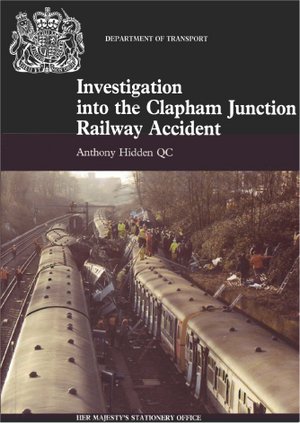Clapham Junction i det sydvestlige London - eller et punkt ca 800 meter sydvest for stationen - blev scenen for en alvrolig jernbaneulykke med to kollsioner mellem tre tog kl 08:10 om morgenen den 12. december 1988. 35 mennesker døde og over ethundrede blev kvæstet, hvilket gjore ulykken til en af de værste i UK. 
Den første kollision opstod da føreren af toget 07:18 fra Basingstoke til Waterloo så et sognal foran sig, der pludselig skiftede fra grønt til rødt uden at gå over det mellemliggende „amber“ aspekt. Som foreskrevet standsede han sit tog ved det næste signal og ringede til stationsbestyreren (signalman) ved Clapham Junction kommandopost A. Han fik at vide, at der ikke var nogen fejl og at han måtte fortsætte. Føreren fortalte at han ville lave en indberetning når han nåede Waterloo. Idet føreren satte telefonen på plads blev hans tog ramt bagfra med en hastigehed på ca. 65 km/t af det forsinkede 06:14 fra Poole, der kørte på falske 'clear' signaler. Endnu en kollision kort efter involverede et tomt tog fra Clapham Junction, der ramt vragene. Et fjerde tog, der også kørte på falske clear signaler nåede at satndse ca. 60 m bag bagenden af toget fra Poole.
The direct cause of the disaster was sloppy work practices in which a stray wire created a false feed to a signal relay, which caused a signal to show green when it should have shown red. A contributing technical factor was the lack of double switching in the signal relay circuits, which would have prevented a single false feed causing an accident. The larger cause of the accident was the failure by British Rail senior management to recognise that the resignalling of the Clapham Junction area; and indeed the resignalling of all the lines out of Waterloo, of which the Clapham Junction work was a part – should have been treated as a major, safety-critical project under the control throughout of a single, senior, named project manager. It was left to middle-level technical staff, stressed, poorly supervised by their seniors and poorly supported by their juniors, with inadequate staff levels and staff dulled by months of voluntary seven days a week work to carry out the complete resignalling of the largest and on some measures the busiest junction on the whole British rail system.
The Hidden Inquiry into the Clapham rail crash found that a supervisor - Mr. Lippett - had noticed some loose wiring during an inspection but had not told anyone about it because he did not want to „rock the boat“. The supervisor's reluctance to raise the issue was characteristic of a form of self-censorship which organisations such as Public Concern at Work (PCaW), founded in 1993, have sought to overcome. I de senere år var balancen In later years, the balance between confidentiality and safety (or in other milieu, societal accountability) has been addressed in part by so-called „whistleblowing“ legislation such as the UK Public Interest Disclosure Act (1998), and similar provisions in other countries.
The inquiry also recommended the introduction of the Automatic train protection (ATP) system; however the inquiry's recommendation was not acted on. Subsequent crashes such as at Southall in 1997 and Ladbroke Grove in 1999 led to further recommendations for the introduction of ATP, and although it has been installed on some lines, it has not to date been specified for the entire network. In the statement on the Ladbroke Grove crash, the Department for Transport sought to make the point that „no workable system was available in Britain“ at the time.
Any recommendation for enhanced safety systems must assume absolutely that those systems are correctly installed and correctly maintained. Unlike a manually-operated signalling system, where safety-critical decisions are made by the signalman every time a signal is changed or points switched, an automatic system has these decisions wired in at the design and construction stages. If the design and construction are flawless, the decisions will always be correct. If faults occur, whether as a result of equipment failure or (as here) from human error in the relay room, the decisions will be arbitrary. It is not apparent, therefore, that ATP on the lines out of Waterloo would have prevented this accident, since the ATP could have also been bypassed by the false feed wrong side failure.
A memorial marking the location of the crash site is to be found atop the embankment above the railway on Windmill Road by Spencer Park, Battersea.
Clapham Junction var kun den 3. jernbaneulykke, der blev undersøgt efter reglerne i xxxxx (de forrige var Tay Bridge og xxx), men det var langtfra den værste engelske jernbaneulykke. Faktisk havde de britiske baner over lang tid hafr en ganske god sikkerhed uden væsentlige ulykker, men Clapham junction fulgte ulykken med Herald of Free Enterprise og branden på Kings Cross.
See also
External links
- Map of the location of the crash, from Multimap.co.uk. The crash site is between the Emanuel School and Spencer Park.
